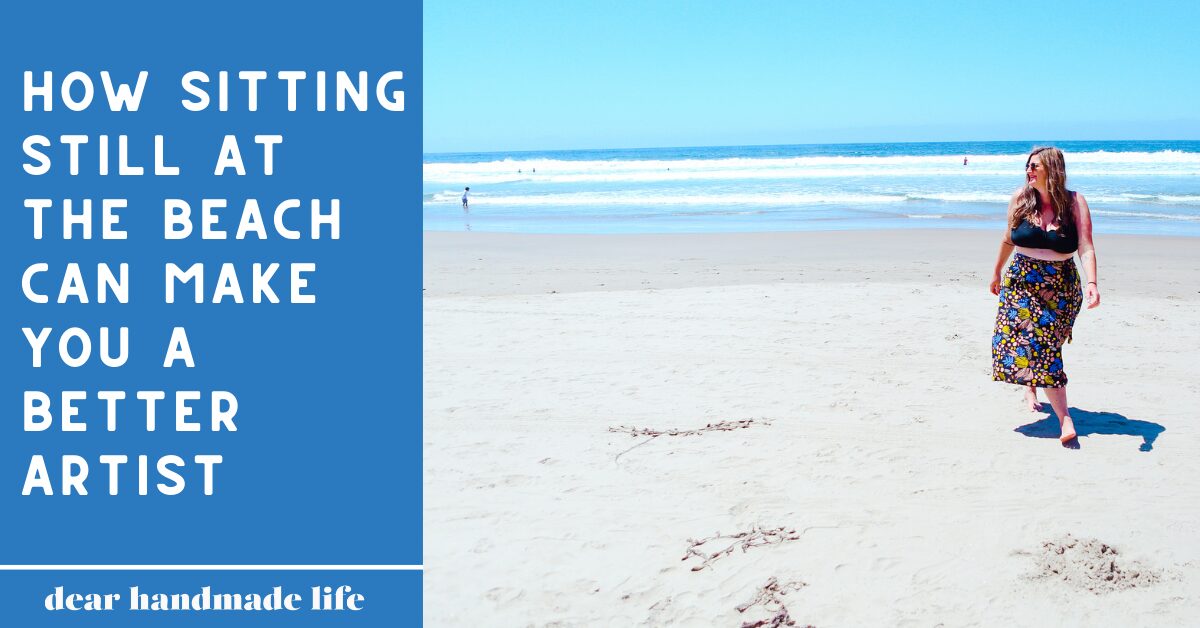HOW SITTING STILL AT THE BEACH CAN MAKE YOU A BETTER ARTIST

i've never been great at sitting still . . .
As a kid, I didn’t just watch TV but created choreographed dance numbers to theme songs like Three’s Company. While others played in the schoolyard, I crafted tissue box houses for roly-polies I “rescued.” Before turning ten, I monetized my crafts, selling handmade stationery to neighbors and chocolates outside my dad’s barbershop. I fell for my first love when he said he was just “sitting and thinking of nothing” after I met him sitting on a bench outside our college dorm. My heart swelled at the idea of someone who could be content doing nothing, and I hoped he’d teach me to be present and not worry about the past or future.
I’ve always struggled to understand boredom, the benefit of doing nothing, or the allure of internet rabbit holes. I often hear Gene Wilder delivering Roald Dahl’s line in Willy Wonka & the Chocolate Factory: “We have so much time and so little to do. Strike that, reverse it.” There is and always has been so much to do.
So much to capture, to feel, to create, to wonder about and at… Stillness has always felt like a waste of precious moments.
Except when I’m near water.
My mom tells a story about taking me to the beach as a baby. She’d set up my playpen, and I wouldn’t fuss while she baked in the sun. Even then, being near water soothed my busy spirit.
Take me to the beach, and I’ll spend hours entranced by the rhythm of the sea. Floating down the Russian River in a kayak or lounging by a lake or pool—these places draw me in and make it easy to embrace presence.
It wasn’t until my 40s, reading about the effects of negative ions on mental health, that I understood my lifelong affinity for places that breed these molecules, which feel like nature’s Xanax to my anxious self.
Finally, scientific proof explained why I couldn’t watch a movie without crafting at home but had no problem simply doing one thing at a time or even nothing on the bank of a river, pool, or ocean.
If all this negative ion talk sounds woo-woo, I get it. But scientific studies back up the benefits: increased serotonin and melatonin levels, lower cortisol, improved respiratory function, and enhanced energy levels.
You’re reading this just in time for the best season of the year (seriously, why isn’t it an official season?):
Negative Ion Season (aka summer)!
Sure, you can forest bathe or use salt lamps and air purifiers, but doesn’t floating down a river or swimming in the sea sound way more fun?
It’s not just my mental health that benefits from negative ions; my creativity does too. As Lila Rogers said, “Downtime is essential for creative thought.” How can your brain create if it’s always busy? Bodies of water and their negative ions may not be your thing. What works for me may not work for you. Think about it—how many ideas came to you in the shower, on a walk, or while driving? It’s your unique magical space where creativity thrives.
Albert Einstein imagined scenarios while walking or riding his bicycle, leading to his theories of relativity.
Maya Angelou found inspiration while cooking, reflecting, and composing before translating into powerful prose.
Agatha Christie conceived plot twists while taking baths.
Virginia Woolf got the idea for Mrs. Dalloway in a department store queue.
The challenge is finding what works for you. Maybe being near water helps calm your mind and allows creativity to flow?
Your homework is to find and make time for the space that opens you up to your creative thought process. Embrace the places and moments where your mind can wander freely, where ideas are born, and you find yourself in the flow, forgetting about time, hunger, and even going to the bathroom. Perhaps it’s on a quiet beach soaking up negative ions, or maybe it’s eavesdropping on strangers’ conversations at a dive bar. The destination isn’t what matters; it’s where it leads you.

